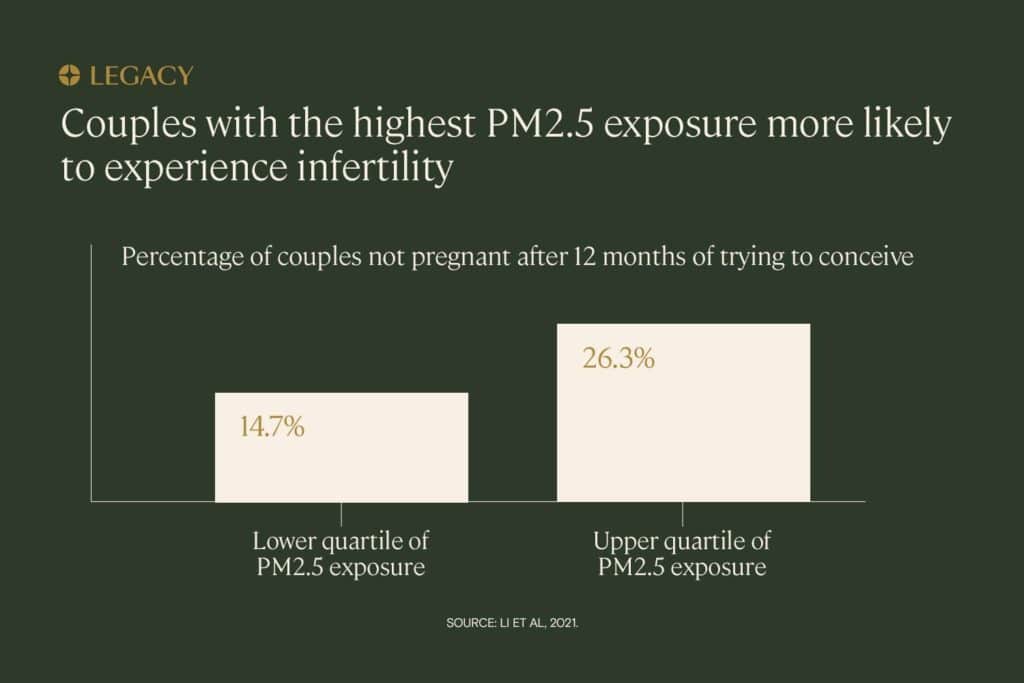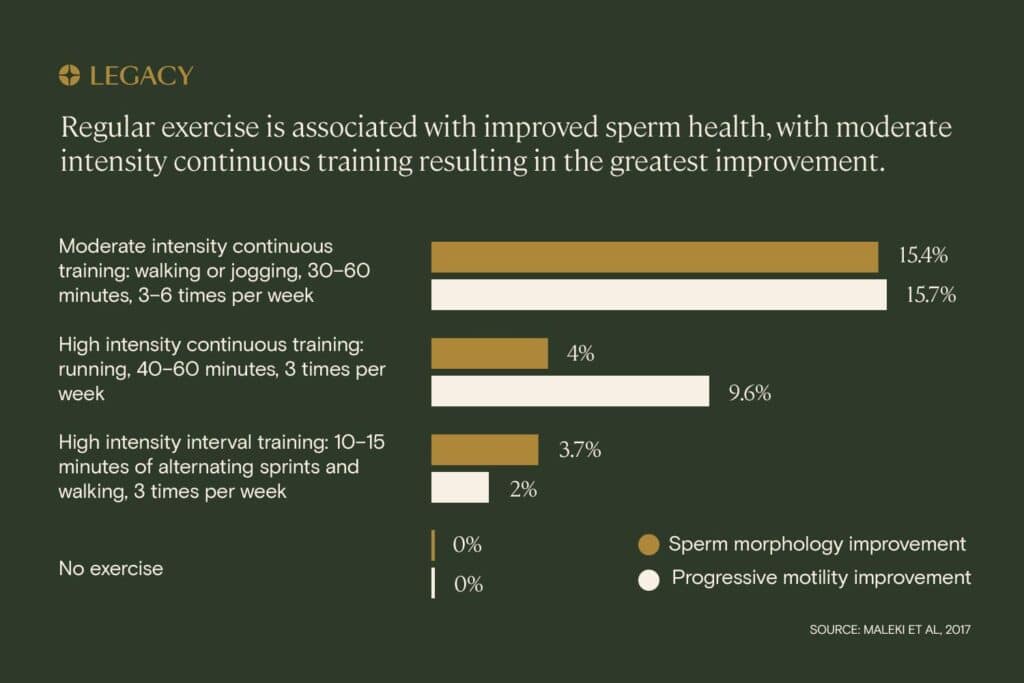If you are thinking about trying to conceive or starting your family-building journey, you’ve likely thought about many different aspects of your life. But have you thought about your immediate environment?
Maybe you’ve thought about your support network and schools for the future, but have you thought about the air quality, access to medical care, or how where you live impacts your lifestyle? Here are a few things to consider.
How the environment affects fertility
Air pollution and fertility
The World Health Organization (WHO) states that air pollution is one of the most significant environmental risks to health. We discuss air pollution in terms of particulate matter (PM). The most damaging particles have a diameter of 2.5 microns or less (PM2.5). These particles put you at a higher risk of heart and lung diseases, including lung cancer.
So what has that got to do with fertility? There have been several studies linking poor air quality to infertility. In 2021, a large study published in the journal Environment International looked at over 10,000 couples, comparing air pollution and fertility rates. It found that couples with the highest exposure to PM2.5 pollution had an increased time to pregnancy (for those that did conceive) and a greater rate of infertility — a 20% increased likelihood — compared to those with the lowest exposure.
Once born, babies and children can also be affected by air pollution. The British Lung Foundation advises that air pollution can harm normal lung growth and function in the womb, during childhood, and in late teens. Air pollution is also associated with a higher incidence of childhood asthma and asthma attacks.

Climate and fertility
Warmer temperatures and environments are linked to lower sperm production. To understand why, we need to review the sperm production process.
Sperm are created in the testes at an optimal temperature of about 93–94ºF — approximately 5º cooler than body temperature. That’s why the scrotum hangs away from the body, so it can control and adjust for the temperature of the testes. Higher temperatures outside the body may raise the temperature inside the scrotum, affecting sperm production.
And indeed, we do see lower fertility measures during hotter periods and in hotter climates. More births occur in August and September in the US, nine months after the coldest part of the year, than in any other months. In a study published in the journal Demography, researchers found that days with a mean temperature above 80°F were correlated with a large decline in birth rates 8–10 months later. This is likely not because people have less sex in hot weather — they actually have more sex — but because of the weather’s effect on sperm production.
Comparison of semen analyses collected in the summer and winter have found similar results. A 1988 study of men in New Orleans found that semen specimens collected during the summer had “significantly lower sperm concentration, total sperm per ejaculate, percent motile sperm, and motile sperm concentration than samples provided at other times of year,” especially for men whose jobs were not air-conditioned.
The same research team followed up with a small study of men in San Antonio in 1990. Again, they found that summer spelled “significant reductions” in sperm concentration (32%), total sperm count (24%), and sperm motility (28%). They also found that the impact of heat was most detrimental on men who already had lower semen parameters.
What happens if your climate gets warmer over time? Climate change is another environmental factor suspected to impact male fertility negatively. Although researchers have carried out many studies on animals, climate change, and fertility, there has been limited research into climate and human male fertility. Scientists aren’t exactly sure how climate change will affect male fertility, but we do know that an increase in environmental temperature could be detrimental to sperm.
Green space and fertility
One study found that exposure to residential greenness — think parks, forests, gardens, and other undeveloped space — was significantly associated with higher semen quality. Scientists aren’t exactly sure why, but they think residential greenness reduces air pollution, heat, and noise, and improves mental and physical health.
Lifestyle and fertility
Certain locations can promote — or discourage — healthy lifestyle choices such as time spent outdoors, physical activity, and healthy eating.
Are you able to remain active in your neighborhood? Sedentary lifestyle choices can impact fertility, in particular male fertility. Research identifies that men with a sedentary lifestyle are more likely to have poorer semen parameters than those who are physically active. Easy access to spaces that promote exercise, like walking trails, parts, or swimming areas, can help you maintain a fertility-friendly lifestyle.
How much vitamin D do you regularly get? Vitamin D is necessary to help our body absorb nutrients like calcium, magnesium, and phosphate. Studies have shown that men with low vitamin D levels can have lower sperm motility, poorer semen parameters, and reduced sex hormone levels. The best way to get vitamin D is through safe sun exposure — i.e. time spent outdoors in the sun — but that’s not always possible depending on where you live and your job role. If you don’t feel you can get the vitamin D you need where you live, you can try a supplement, as this can help increase sperm quality.
Finally, our physical locations, including where we live and work, often determine whether we have easy access to nutritious food. A diet rich in fruits and vegetables and seafood may help improve your sperm health. It’s logical to assume that it’s easier to get healthy foods if you live in a place with a farmer’s market and abundant grocery options, as opposed to a food desert.
This may also lead you to look at your environment and the lifestyle it will give you as a family. Does your environment fit with how you want to raise your child? Can you easily access family activities? Are you able to have a healthy lifestyle? It’s always good to think about these things when trying to start a family.

Access to fertility care
Where you live may affect your ability to actually get fertility care.
A 2017 report published by the American Society for Reproductive Medicine (ASRM) stated that nearby geographic access to ART services is limited or absent for more than 25 million reproductive-age women.
Lisa Schuman, LCSW, a fertility-focused social worker and director of The Center for Family Building, advises that there are many fertility clinics all over the country. But, if you live in a rural or remote area, you may not be able to access a fertility clinic that fits your needs as easily. Schuman says that the closer you are to a sizable metropolitan city, the more likely you are to be able to access a fertility center. This is supported by the ASRM report, which states multiple ART clinics are present in 76 metropolitan areas across the US.
If you are considering sperm or egg donation to build your family, your local fertility clinic might not have a suitable donor for your family, especially if you are looking for a specific ethnicity. You may have to travel to find the right clinic and donor. You might also find it harder to find a clinic that is LGBTQ+ friendly if you are not in a large city. You also may have more difficulty with the legalities of surrogacy in certain states.
“So, it can be hard to access the right fertility treatment for you,” says Schuman, “depending on where you live and your fertility requirements.”
Social support
Social support might come in the form of friends, family, colleagues, counseling, or support groups. Whatever that social support network looks like to you, it is vital to have alongside you when you’re trying to conceive — and when you have a baby.
A small study conducted with just over 300 women in the US found that women who revealed information about their infertility face-to-face, with the opportunity for an immediate response, had better quality support and a better quality of life.
Schuman also discusses that if you are a LGBTQ+ couple building a family, it can make it more challenging to find a community that offers you social support. It can be exhausting to deal with discrimination against LGBTQ+ families and prejudice from people who dislike surrogacy, fertility treatments, and other ways of building a family.
Being part of a community and culture that supports you and your family as it grows is something to consider. It helps to connect with other LGBTQIA+ families who have already navigated this path. There are also resources and support groups available to help you on your family-building journey.
Some great places to look for fertility support in your area include: